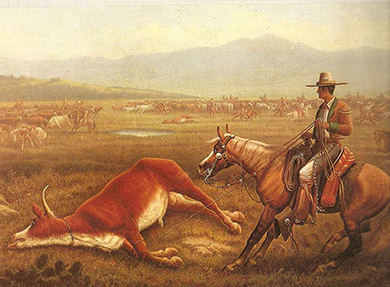| << Chapter < Page | Chapter >> Page > |
The Treaty of Guadalupe Hidalgo, which ended the Mexican-American War in 1848, promised U.S. citizenship to the nearly seventy-five thousand Hispanics now living in the American Southwest; approximately 90 percent accepted the offer and chose to stay in the United States despite their immediate relegation to second-class citizenship status. Relative to the rest of Mexico, these lands were sparsely populated and had been so ever since the country achieved its freedom from Spain in 1821. In fact, New Mexico—not Texas or California—was the center of settlement in the region in the years immediately preceding the war with the United States, containing nearly fifty thousand Mexicans. However, those who did settle the area were proud of their heritage and ability to develop rancheros of great size and success. Despite promises made in the treaty, these Californios—as they came to be known—quickly lost their land to white settlers who simply displaced the rightful landowners, by force if necessary. Repeated efforts at legal redress mostly fell upon deaf ears. In some instances, judges and lawyers would permit the legal cases to proceed through an expensive legal process only to the point where Hispanic landowners who insisted on holding their ground were rendered penniless for their efforts.
Much like Chinese immigrants, Hispanic citizens were relegated to the worst-paying jobs under the most terrible working conditions. They worked as peóns (manual laborers similar to slaves), vaqueros (cattle herders), and cartmen (transporting food and supplies) on the cattle ranches that white landowners possessed, or undertook the most hazardous mining tasks ( [link] ).

In a few instances, frustrated Hispanic citizens fought back against the white settlers who dispossessed them of their belongings. In 1889–1890 in New Mexico, several hundred Mexican Americans formed las Gorras Blancas (the White Caps) to try and reclaim their land and intimidate white Americans, preventing further land seizures. White Caps conducted raids of white farms, burning homes, barns, and crops to express their growing anger and frustration. However, their actions never resulted in any fundamental changes. Several White Caps were captured, beaten, and imprisoned, whereas others eventually gave up, fearing harsh reprisals against their families. Some White Caps adopted a more political strategy, gaining election to local offices throughout New Mexico in the early 1890s, but growing concerns over the potential impact upon the territory’s quest for statehood led several citizens to heighten their repression of the movement. Other laws passed in the United States intended to deprive Mexican Americans of their heritage as much as their lands. “Sunday Laws” prohibited “noisy amusements” such as bullfights, cockfights, and other cultural gatherings common to Hispanic communities at the time. “Greaser Laws” permitted the imprisonment of any unemployed Mexican American on charges of vagrancy. Although Hispanic Americans held tightly to their cultural heritage as their remaining form of self-identity, such laws did take a toll.
In California and throughout the Southwest, the massive influx of Anglo-American settlers simply overran the Hispanic populations that had been living and thriving there, sometimes for generations. Despite being U.S. citizens with full rights, Hispanics quickly found themselves outnumbered, outvoted, and, ultimately, outcast. Corrupt state and local governments favored whites in land disputes, and mining companies and cattle barons discriminated against them, as with the Chinese workers, in terms of pay and working conditions. In growing urban areas such as Los Angeles, barrios , or clusters of working-class homes, grew more isolated from the white American centers. Hispanic Americans, like the Native Americans and Chinese, suffered the fallout of the white settlers’ relentless push west.
In the nineteenth century, the Hispanic, Chinese, and white populations of the country collided. Whites moved further west in search of land and riches, bolstered by government subsidies and an inherent and unshakable belief that the land and its benefits existed for their use. In some ways, it was a race to the prize: White Americans believed that they deserved the best lands and economic opportunities the country afforded, and did not consider prior claims to be valid.
Neither Chinese immigrants nor Hispanic Americans could withstand the assault on their rights by the tide of white settlers. Sheer numbers, matched with political backing, gave the whites the power they needed to overcome any resistance. Ultimately, both ethnic groups retreated into urban enclaves, where their language and traditions could survive.

Notification Switch
Would you like to follow the 'U.s. history' conversation and receive update notifications?